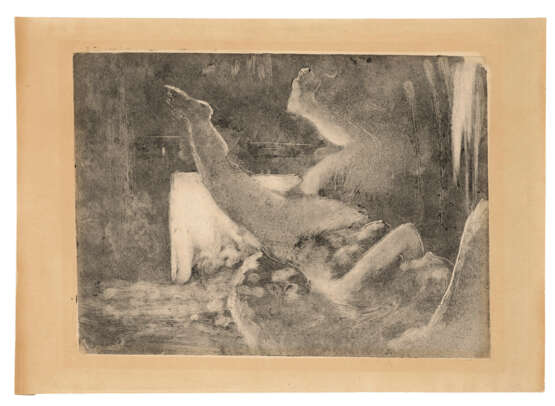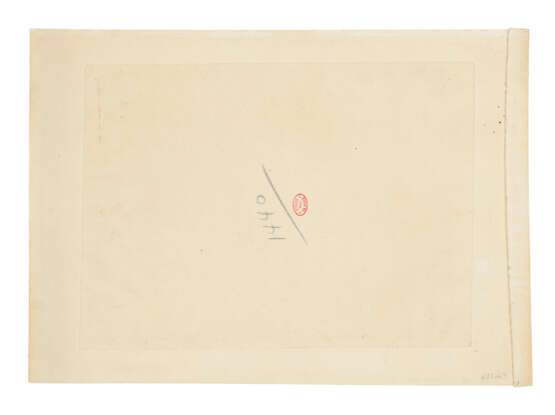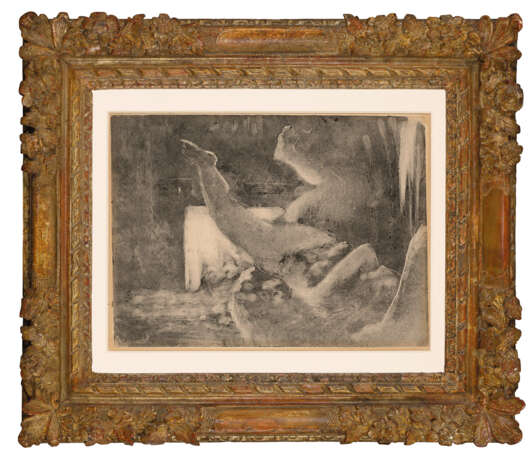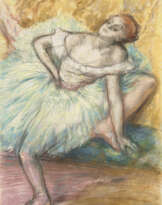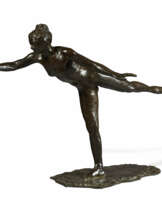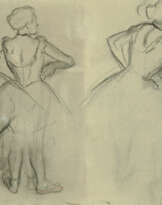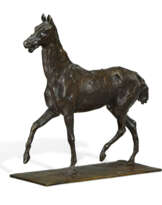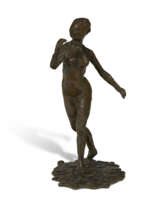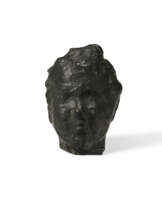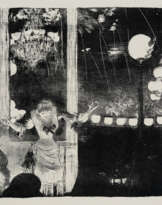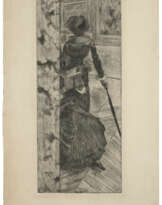ID 1051685
Lot 120 | Edgar Degas (1834-1917)
Estimate value
€ 180 000 – 250 000
Femme nue se chauffant
monotype sur papier vergé, avec filigrane D&C BLAUW
Plaque: 27.8 x 37.9 cm.
Feuille: 34.2 x 50.8 cm.
Exécuté vers 1880-85, superbe première impression, avec le cachet de l'atelier de l’artiste ( Lugt 657 verso)
monotype on laid paper, watermark D&C BLAUW
Plate: 10 7⁄8 x 14 7⁄8 in.
Sheet: 13 3⁄8 x 19 7⁄8 in.
Executed circa 1880-85, a superb first impression, with the artist's atelier stamp (Lugt 657 verso)
Provenance
Atelier Degas, vente, Paris, 22-23 novembre 1918, Mes. Dubourg et Delvigne, lot 251 (355FF).
Ambroise Vollard, Paris (acquis lors de cette vente).
Probablement avec Henri Marie Petiet, Paris.
Sam Josefowitz, Pully.
Puis par descendance aux propriétaires actuels.
Exhibited
Martigny, Fondation Pierre Gianadda, Degas, juin-novembre 1993, p. 169, no. 112 (illustré).
Copenhague, Ordrupgaard, Degas intime, octobre-décembre 1994, no. 57 (illustré).
Vevey, Cabinet cantonal des estampes; Quebec, Musée du Québec, Jérusalem, The Israel Museum, Degas & Pissarro: Alchimie d'une rencontre, août 1998-octobre 1999, p. 134, no. 106 (illustré).
Ornans, Musée Courbet, Cet obscur objet de désirs, Autour de "L'Origine du monde", juin-septembre 2014, no. 19 (illustré en couleurs, p. 64).
New York, Museum of Modern Art, Degas, A Strange New Beauty, mars-juillet 2016, no. 103 (illustré).
Further details
Degas a été initié à la technique du monotype en 1876 par son ami et confrère Ludovic Lepic (1839-1889), ce qui a déclenché une intense période de créativité dans ce domaine. De nombreux monotypes représentent des scènes de prostituées dans des intérieurs de maisons closes et n'ont jamais été exposés en public du vivant de l'artiste en raison de leur sujet risqué. Les femmes sont souvent représentées en train d'attendre leur prochain client, de dormir, de s'occuper de leur toilette ou de lire un livre. Dans Femme nue se chauffant, une femme nue est allongée sur un divan dans une pièce sombre, les jambes ouvertes, se réchauffant devant le feu. Ce tableau fait partie d'une série de grands monotypes à la manière des "champs sombres" que Degas a réalisés à cette époque. Dans cette méthode, la plaque est entièrement recouverte d'encre et l'image est créée en essuyant l'encre à l'aide d'un chiffon, d'une gaze ou d'un instrument pointu, afin de créer des rehauts et des demi-teintes. Cette méthode est particulièrement adaptée à la représentation de scènes nocturnes, comme dans cette œuvre atmosphérique, où Degas manipule la surface encrée pour évoquer les effets vacillants de la lumière du feu sur le corps de la femme, les rideaux et le lit.
Si Raisa Rexer évoque l'influence de la photographie érotique, omniprésente en Europe dans les années 1880, elle soutient que les monotypes de Degas détournent les tropes visuels de la pornographie et offrent une représentation plus sympathique des réalités de la prostitution. À propos de cette estampe, elle déclare: "Les surfaces travaillées à la main de tous les monotypes constituent un rejet de l'exactitude mécanique de l'appareil photo, de sa précision inébranlable dans l'exposition du corps des femmes au regard de l'observateur, mais Femme nue se chauffant a une qualité visuelle brumeuse et lunatique qui la met encore plus à l'écart. Elle n'évoque pas explicitement l'intérieur d'une maison close, et le cadre qu'elle évoque - un cocon d'obscurité, de chaleur et de domesticité - constitue un autre rejet de la lecture habituelle de sa pose sexualisée et des photographies dont elle est tirée" (R. Rexer, “Stockings and Mirrors”, in: Degas, A Strange Beauty, op. cit., p. 139).
Degas was introduced to the monotype technique in 1876 by his friend and fellow artist Ludovic Lepic (1839-1889), initiating an intense period of creativity in the medium. Many depict scenes of prostitutes in brothel interiors and were never exhibited in public during the artist's lifetime because of their risqué subject matter. The women are often shown at leisure as they wait for their next customer, sleeping, attending to their toilette or reading a book. In Femme nue se chauffant, a nude woman lies on a divan in a darkened room, her legs open, warming herself in front of the fire. It belongs to a series of large 'dark field' manner monotypes which Degas completed during this period. In this method the plate is completely coated with ink and the image created by wiping away ink with a rag, gauze or sharp implement, to make highlights and half-tones. It is particularly well suited to depictions of scenes at night, as in this atmospheric work, where Degas manipulates the inked surface to evoke the flickering effects of firelight as it plays over the woman's body, the curtains and bed.
While Raisa Rexer suggests the influence of erotic photography, ubiquitous in Europe by the 1880's, she argues that Degas's monotypes subvert the visual tropes of pornography and offer a more sympathetic rendering of the realities of prostitution. Referencing this print, she says: `The hand-worked surfaces of all the monotypes constitute a rejection of the camera's mechanical exactitude, of it's unflinching precision in exposing women's bodies to the observer's scrutiny, but Nude Woman by a Fireplace [Femme nue se chauffant] has a hazy, moody visual quality that sets it still farther apart…it does not explicitly evoke the interior of a brothel; and the setting that it does evoke - a cocoonlike den of darkness, warmth, and domesticity-constitutes another rejection of the usual reading of her sexualized pose and the photographs from which it was taken' (R. Rexer, ‘Stockings and Mirrors’, in: Degas, A Strange Beauty, op. cit., p. 139).
| Artist: | Edgar Degas (1834 - 1917) |
|---|---|
| Applied technique: | Monotypе |
| Medium: | Acrylic glass, Plastic |
| Art style: | Impressionism |
| Place of origin: | Western Europe, France, Europe |
| Artist: | Edgar Degas (1834 - 1917) |
|---|---|
| Applied technique: | Monotypе |
| Medium: | Acrylic glass, Plastic |
| Art style: | Impressionism |
| Place of origin: | Western Europe, France, Europe |
| Address of auction |
CHRISTIE'S 9 Avenue Matignon 75008 Paris France | ||||||||||||||
|---|---|---|---|---|---|---|---|---|---|---|---|---|---|---|---|
| Preview |
| ||||||||||||||
| Phone | +33 (0)1 40 76 85 85 | ||||||||||||||
| Fax | +33 (0)1 40 76 85 86 | ||||||||||||||
| Conditions of purchase | Conditions of purchase | ||||||||||||||
| Shipping |
Postal service Courier service pickup by yourself | ||||||||||||||
| Payment methods |
Wire Transfer | ||||||||||||||
| Business hours | Business hours
|
